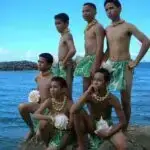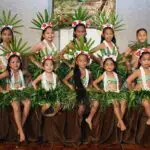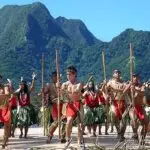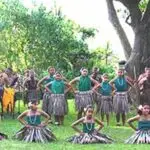CHamoru/Chamorro Dance





Table of Contents
Share This
From ancient times to the present
Native dance of the CHamoru/Chamorro people was only vaguely described by early visitors to the Mariana Islands. The Jesuit annual report for 1669 to 1670 provides a rare description of a women’s dance. A group of twelve or thirteen women swayed their bodies in place, moving their hands in a pleasing rhythm. In their right hands they flourished some half-moons and in their left hands they held little boxes of shells and bells to keep rhythm. They accompanied their dance with singing in three-part harmony, including falsetto, led by a man in tenor voice. Their songs told of their history and “antiquities” (perhaps genealogies).
Slapping rhythms and the combination of movements was described as very pleasing. The mention of half-moons and bells is not explained; and therefore it is not known if these were of recent importation since western contact or were locally produced.
The description of dance costume and ornamentation is equally vague. The women wore fragrant flowers on their foreheads (perhaps garlands) and sometimes strings of red shells (possibly Spondylus) on which turtle shell or other trinkets were hung. They also girded their waists with these same highly-valued shells, and hung from them “small, well-formed coconuts” on strings made from tree roots. These skirts were more like a birdcage that revealed the body rather than covering it.
The next historical description of native dance was made by French explorer Louis Claude de Freycinet in 1819, specifically because he requested to see native dance. He was told that the dance was performed on great feast days, where men and women alternated in a circle. The person being honored stood in the center while they sang praises about him or her.
By the time of Freycinet’s visit it is apparent that indigenous dance was being overshadowed by Spanish influences. He described a celebration organized by the Spanish governor based on the “dances of Montezuma” imported from Mexico. The dancers wore colorful, richly trimmed silk and satin costumes that were brought out only for this type of performance. He also described how the people of Hagåtña informally entertained them by having their children dance around a sombrero, the boy chasing the girl who coquettishly allowed him to kiss her cheek at the end.
Oral histories of elders who lived in the early 1900s only recall the dances introduced during the Spanish Colonial Period, such as the Spanish Waltz, called the batsu, and the so’tis, with timing and footwork like the European Polka.
The bailan ha’iguas, or “coconut shell dance” is believed to have originated in the Philippines, which involves striking half coconut shells held in each hand in a variety of rhythmic patterns between dancers, with footwork and movements to a lively ¾ beat. The same rhythm and musical beat is accompanied by thin arms-length sticks held in each hand, struck together in intricate patterns in another dance called the bailan pailitu, or “stick dance”.
The music and songs used for such dances are distinctly Spanish or Mexican in style, although they have Chamorro lyrics that range in themes from farming to fishing to courtship and are often flirtatious or with romantic innuendos.
Spanish influences dwindled as the American Naval Period, which began in 1899, progressed. Chamorros embraced Big Band music introduced by the navy bands which provided entertainment in the Plaza de España in Hagåtña every Friday night; and they danced ballroom waltzes, ragtime and flapper dance styles as they became popular in the United States. Cha cha, tango, rock n’ roll, and jitterbug became popular after World War II. By then, the Spanish Period dances became known as “traditional dance.”
Revival of Chamorro dance
Francisco “Frank” B. Rabon was awarded the title of “Master of Chamorro Dance” by the governor of Guam in the early 1990s for his lifetime work of reviving the concept of native Chamorro dance. He was never exposed to indigenous forms of dance until he went to college in the United States. There, he gravitated towards the Hawaiian islanders, and learned their dances.
Tourism from Japan flourished beginning in the early 1970s, and when he returned to Guam in 1983 he continued to dance with Polynesian groups who performed in the hotels that had begun to line Tumon Bay. In 1984 he was introduced to former Legislative Speaker Carlos Taitano, who had traveled extensively in the Pacific after being educated in the United States. He enlisted Rabon’s help in choreographing Guam’s presentation for the Festival of Pacific Arts that was held in Tahiti in 1985.
This exposure to the idea of a Chamorro indigenous identity inspired Rabon to experiment with forms of Chamorro dance that drew on historical documents and dances from other Pacific islands. His training in Polynesian dance heavily influenced his dance movements and he continued to use the Hawaiian gourd instrument to keep rhythm.
Through his Taotao Tano’ dance group (meaning “people of the land”) he introduced dances that depicted activities of ancient Chamorro life to re-create ancient Chamorro dance. As he has repeated many times, he is not trying to authenticate dances as being carried down from ancient times. Rather, his goal is to create an indigenous Chamorro identity that can give Chamorros of today a sense of pride in their heritage. Rabon’s dance creations have provided a basis for Chamorro dance that is being passed to successive generations by his original students.
The signature dance of the ancient Chamorro era is called the Bailan Uritao, or “Young Man’s Dance,” based on historical descriptions of the warrior-training practices of the uritao – young unmarried men who lived in the men’s house or guma’ uritao prior to marriage. The lively jumps, shouts, and crashing together of long sticks called tunas requires precision and agility and shows the prowess of a warrior. The rhythm and pattern of the sticks hitting together actually depicts the building of a latte house, finally ending with all sticks held upwards forming the pointed roof of the house.
This usually leads to the next signature dance, the Bailan Lina’la’, or dance of life, which starts with the women dancers coming through the arched roof formed by the uritao sticks. This dance depicts the women’s dance first described in the Jesuit reports. For modesty’s sake, Rabon created a natural, coconut leaf skirt and a top for the women rather than the revealing skirt described in historical documents. The men adopted the sadi’, or Micronesian-style thu.
Rabon and his successive students, as well as others indirectly influenced by his work, have choreographed many other dances and written many other songs for dances. He and his followers have developed dances around three historical periods: Ancient Period, Spanish Colonial Period, and Contemporary Period. The Festival of Pacific Arts has been a significant influence on the development of Ancient Period dance in particular.
Hawaiians expressed concern about the “borrowing” of movements, sounds, and especially the use of the Ipu Heke gourd. Rabon and other organizers of various dance competitions have encouraged choreographers to look to their own historical influences and especially to the regional Micronesian styles to create dances that more closely reflect the Chamorro heritage.
The number of dance groups has proliferated to the extent that native Chamorro dance in all its historical presentations is now valued and sought out by the tourism industry. Several public schools have dance groups that filter into after-school, community dance groups. In 1999 Rabon organized a coalition of the existing dance groups, called “Pa’a Taotao Tano’,” meaning “the way of life of the people of the land.”
Members of this coalition represent many schools and communities all over the island. The dance group leaders, called Maestros, have dedicated countless volunteer hours to build their membership, group pride, and to choreograph dances that earn them recognition and awards at the annual Dinana’ Minagof Dance Festivals each year.
Gef Pa’go Chamorro Cultural Village in Inalahan hosts their Dinana’ Minagof Festival every year during the second week of February. Pa’a Taotao Tano’ hosts their Dinana’ Minagof Dance Competitions every June in the Tamuning/Tumon area.
Pa'a Taotao Tano' dance groups
Below is a list of recognized Guma (cultural houses) and their fafa’na’gue (certified Guma leader) or Guma leader. For updated information please contact the Guam Council on the Arts and Humanities Agency (CAHA) and reference their Artist Directory.
| Guma | Fafa’na’gue |
|---|---|
| Guam | |
| Taotao Tano’ | Frank Rabon* |
| Irensian Taotao Tano’ | Eileen Meno** |
| Taotao Lagu | Dana Kim |
| Aniten I Taotao Tano’ | Barbara Tainatongo |
| Rasan Acho Latte | Brian (BJ) Terlaje |
| Pas Ginen San Francisco | Cathy Calvo |
| Ni’na’en Acho Latte | Raymond Lujan |
| Ininan I Sainata | Jonathan Perez |
| Commonwealth of the Northern Mariana Islands (CNMI) | |
| Inatuas (Saipan) | Jonas Barcinas and April Repeki |
| Taotao Taga (Tinian) | Eric Reyes |
| California | |
| Imahen Taotao Tano’ (San Diego) | Rosemary Mantanona |
| Kutturan Chamoru (Long Beach) | Heidi Quenga |
| Japan | |
| Taotao Kinahulo I Atdao na Tano’ | Asami Nohira |
| Famagu’on Tano’ yan I Tasi | Kyoko Nakayama |
| *Master of Chamorro Dance and Creative Director, Pa’a Taotao Tano’ **Master of Chamorro Dance |
For further reading
Flores, Judy. “Art and Identity in the Mariana Islands: Issues of Reconstructing an Ancient Past.” PhD thesis, University of East Anglia, 1999.
Freycinet, Louis Claude Desaulses de. An Account of the Corvette L’Uraine’s Sojourn at the Mariana Islands, 1819. Translated by Glynn Barratt. Saipan: Commonwealth of the Northern Mariana Islands Division of Historic Preservation, 2003.
Kihleng, Kimberlee S., and Nancy P. Pacheco, eds. Art and Culture of Micronesian Women. Mangilao: Isla Center for the Arts and Women & Gender Studies Program, University of Guam, 2000.
Lévesque, Rodrigue. History of Micronesia: A Collection of Source Documents. Vols. 1-6. Québec: Lévesque Publications, 1992-1995.
Rabon, Francisco B. Pa’a Taotao Tano’: A Way of Life, People of the Land. Chamorro Chants & Dances of Guam. Hagåtña: Irensia Publishing, 2001.
Tatge, Catherine, dir. Dances of Life. 2005, PBS documentary. DVD video.
